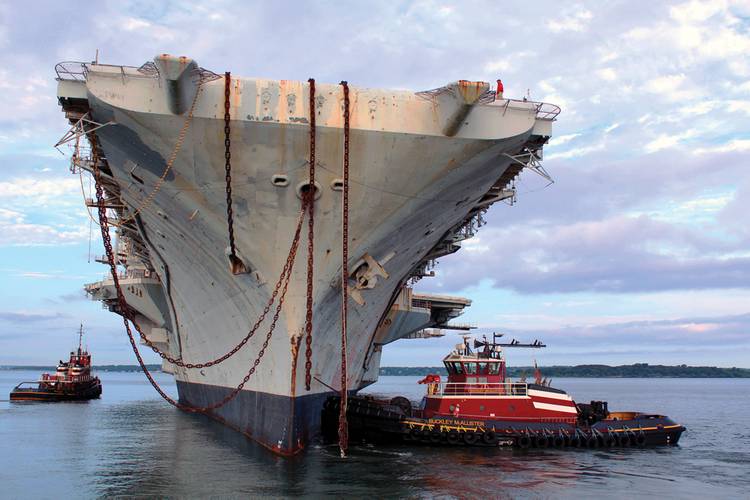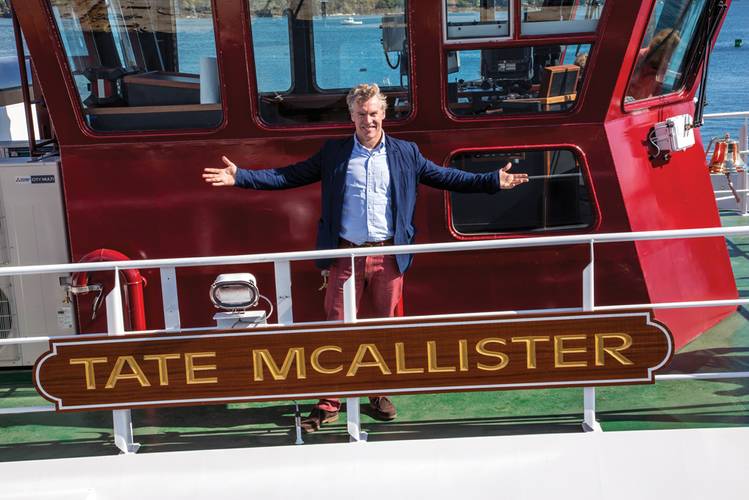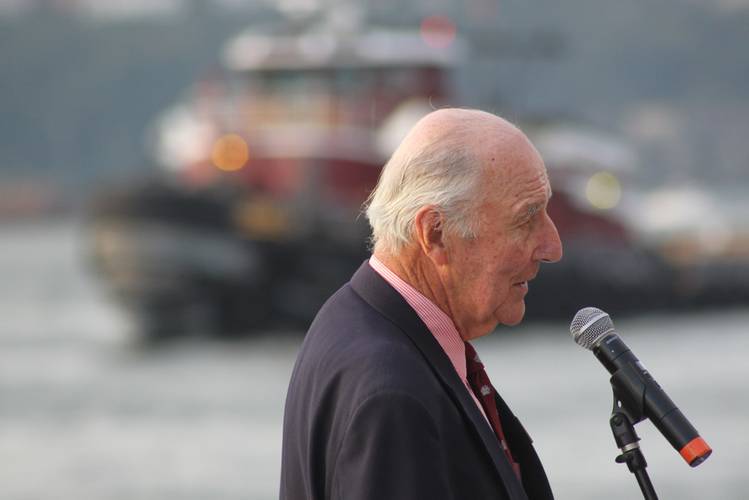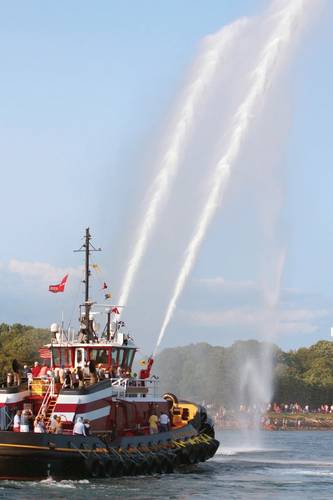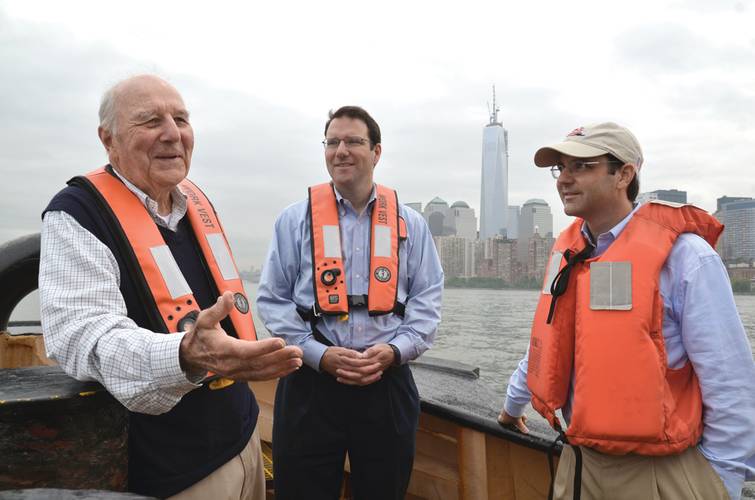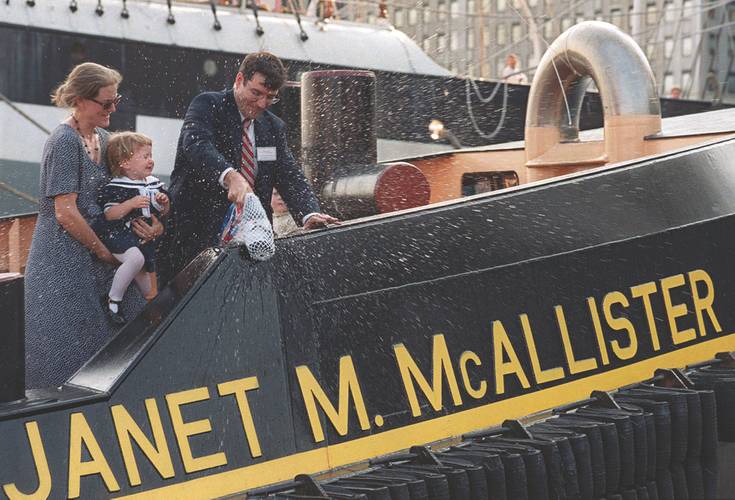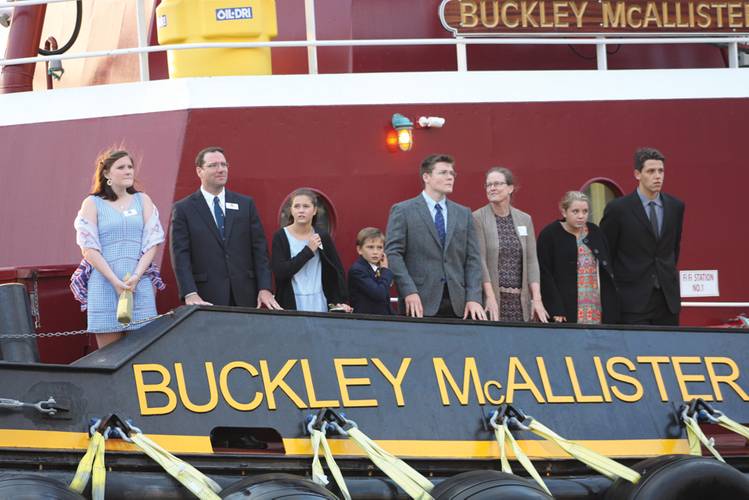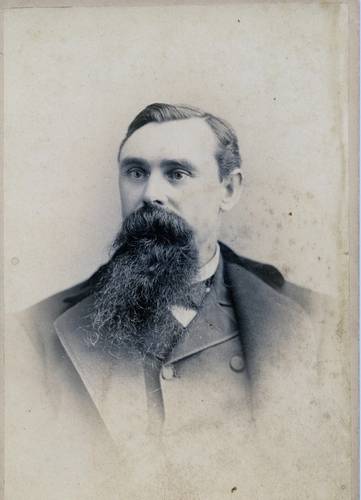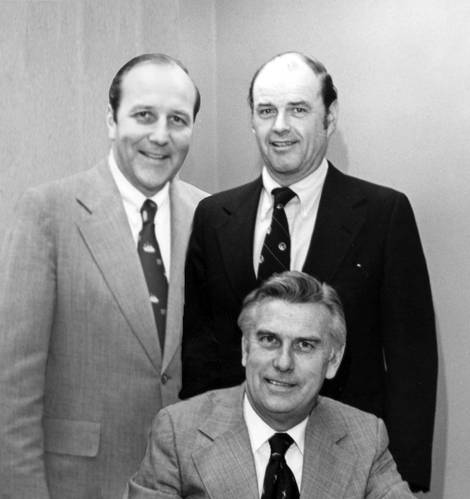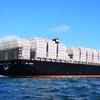The McAllister Towing Legacy
150 Years Young, the 5th Generation Plots the Future Course McAllister Towing
In 1864 Abraham Lincoln was president, and the U.S. was embroiled in the midst of civil war. In 1864, McAllister Towing was established (originally as the Greenpoint Lighterage Co.) in New York City. McAllister Towing has persevered, and at times, served, through nine wars, 28 presidents, at least three catastrophic stock market crashes; collapsing oil prices, generations of advances in ship technology and vessel construction and design; and an explosion in maritime regulation. The company has had its fair share of high tides and low, but through it all, 150 years later, the McAllister flag still flies high.
“Keep the flag flying!”
That’s the advice Brian McAllister gave his sons Buckley and Eric when he handed over the reins of McAllister Towing in 2013 to the fifth generation of family to run the tug and barge company. It’s an apt motto for the venerable New York-based maritime firm, which has been in continuous operation under family control since 1864. Brian’s pithy directive was a substantial step up in positivity from the parting gloom of his (third-generation) father Anthony, who pessimistically told his son in 1974, “You’ll never make it, you can’t buy a company with 100% debt and no working capital,” after the determined 43-year-old teamed up with his fourth-generation brothers, cousins and one outside partner to put together the $20 million needed to snatch the company out from under a competing Wall Street company’s offer at the last minute.
To be sure, it took Brian and his partners four years to finalize the deal, after which they endured a period of “overwhelming” debt – “a terrible struggle for the longest time’’ – only to teeter at least once on the brink of bankruptcy after the oil crash of the ‘80s. But make it they did, and then some.
“The third generation didn’t feel it could trust the fourth generation to make a go of it, but we did,” says Brian with satisfaction.
They shouldn’t have doubted.
Any company that has survived 150 years – and under one family’s ownership – has to have grit, determination and drive. It has to have been innovative, not adverse to risk, and in the forefront of driving and or adopting new technologies, best practices, and even new types of business.
This type of longevity is simply not served by timidity and an overly conservative outlook. In fact, you might say McAllister, or MT&T as it is known, is the ‘Rocky’ of the tugboat business, having come close to going under at least three times in its stubborn history.
But no matter the odds, it appears that family members never gave up, each generation gave it all they had - sometimes in the face of seeming insurmountable adversity - and each generation believed in its ability to turn things around even when their curmudgeonly forefathers had their doubts. (Even the second generation thought the company was done for, and told the third generation to go find jobs elsewhere.)
The company has persevered, and at times, served, through nine wars, 28 presidents, at least three catastrophic stock market crashes; collapsing oil prices, generations of advances in ship technology and vessel construction and design; and an explosion in maritime regulation. The McAllisters are survivors with a capital “S.”
So much so that out of the 700 or so family-owned marine business that once plied their trade in New York’s harbor at the height of its preeminence as the busiest port in the world, McAllister has emerged as one of the few surviving tug companies, and the only one to still remain in family hands. The company today is a successful business offering tug and barge and ferry services with more than 800 employees and 85 vessels operating out of 17 locations.
That’s due in no small way to the leadership and stamina of Capt. Brian McAllister. Despite his father’s doubts, “Brian was the right guy at the right time to put the company on financial footing. He was fiercely determined to continue McAllister as a family-run company,” said Edward J. Kelly, Executive Director, Maritime Association of the Port of New York & New Jersey. “Most people would have bet against him for a lot of reasons – internal conflicts (even in the family), financial strain, etc. But he is the guy who forced this company to survive, and deserves laurels for it. He delivered a functional, profitable and competent company to [his son] Bucky to carry forward,” said Kelly, who has worked with the McAllisters on various industry harbor issues and projects for decades.
The Hand Off
Brian choose to deliver 98% of the company to his sons after a heart attack in 2005 provided evidence his boys were up to the task. “A lot of general managers told me, ‘The one good thing you have going for you is your two sons. We’ve not had one problem since you’ve been in isolation.’ So I figured the best thing I can do is pass the company down,” said Brian. But first, he needed to tackle New York’s “devastating” 60% estate tax, which he feared would plunge his boys into the kind of debt he’d struggled through himself.
So the fifth generation is having its turn at the wheel, bolstered by sage advice from the senior McAllister: Balance debt and aggressiveness; make good earnings; don’t buy too much; keep debt low and prepare for the rainy day which is sure to come.
And if the luck of one of the few remaining flag carriers of the “Irish Navy” in New York Harbor holds, Brian McAllister will see a sixth generation – his grandchildren and perhaps their cousins – run the family flag up the mast pole and pilot the company into its next 25 year-run. There are already flickering signs of interest from the next generation: his 17-year-old grandson Rowan is working as a deckhand, while Rowan’s younger sister Janet worked a summer job in the office as Brian’s assistant.
Their dad Buckley, an attorney by profession who put in his own dues working as a deckhand in his youth, has been plenty busy this year, wrapping up a stint this spring as the chairman of the American Waterways Operators (AWO) while executing his duties as president of the venerable tug and barge company, and meeting commitments to a wide array of maritime organizations, agencies and causes. His brother Eric keeps the financial side of the business on an even keel as vice president of finance and treasurer. Rounding out the family tree in management are Brian, who remains as chairman, and cousins Andrew McAllister, vice president of IT; A.J. McAllister III, senior vice president, sales; and Jeffrey McAllister, senior docking pilot at McAllister Towing of NY. It’s almost as if the prior generation had plotted out the career paths of their children to map into these management posts.
“What better succession planning could a private company enjoy?,” said longtime customer Craig Reinauer, president of Reinauer Transportation. “You have the wisdom of Brian’s years complimented by Buckley and Eric growing up in and around the company. Yet, before joining, they hone their skill set in the legal and financial world before joining McAllister. If I were to see any change [since the handoff to the Fifth Generation, I’d say I see depth and a commitment to the future.”
To ensure that there will be a healthy McAllister Towing to hand down to a sixth generation, generations four and five are working on a multi-faceted strategy that involves preparing for resilience, problem solving for customers, diversification on land and sea, continued modernization and investing of themselves and the company in the industry and their local maritime communities.
Actually, the company has been especially prominent as a force for change and technological advances down through the years in New York harbor, says Kelly, who noted that the McAllister’s forefathers were among the first to join his organization, which dates back to 1873.
“The McAllisters are outward looking. They understand that to be effective in the industry, you have to be an active player in it.”
Multi-Generational Relationships
It’s not just longevity in family ownership that has kept McAllister afloat the past century and a half. The company can boost multi-generational – third, fourth and fifth generation – employee dynasties, as well as business relationships that stretch back almost 100 years. At least one family of employees – the Tookers – is in its fifth generation working for the company, marvels Buckley McAllister.
In 1883, P.T. Barnum and a group of 26 shareholders launched the Bridgeport & Port Jefferson Steamboat Co. A Capt. Charles E. Tooker and his brother-in-law owned the controlling interest. McAllister eventually acquired the company, and with it apparently, generations of Tooker employees. Today, two Tooker descendants, brothers, work for McAllister as a docking pilot and a ferry captain.
“Being a family company certainly helps with developing relationships with the crew,” says Buckley McAllister, adding that multi-generation employee families “shows the long-term relationships involved in the business, because there really is so much trust and mutual commitment involved.”
On the client side, “Our oldest contract is with a Chilean fruit company – 80 years – but I think our oldest client is the U.S. Navy,” he added. And vice versa. McAllister at one point purchased and retrofitted a number of government tugs when the U.S. Navy decided to get out of the tug business. “To have relationships go back that long is pretty amazing,” said Buckley.
Among McAllister’s oldest clients are Maersk Line (1904), Bouchard Transportation (founded 1918), Reinauer Transportation (founded 1923) and Orient Overseas Container Line (founded 1947).
For some companies, like Reinauer, the ties run deep. “I’ve heard stories that Brian worked for my grandfather as a teenager at a shipyard that, at the time, was a partnership between the Reinauer and McAllister families,” recalls Craig Reinauer. The companies’ relationship, he suggests “predates” both himself and Chairman Brian McAllister. But it’s driven by mutual respect and a commitment to the same values, he adds. “In order for McAllister to work for us, we audit them at the same level that we are, to ensure that they are an extension of the service we offer our customers. The long-term relationship is simple, it’s the philosophy of give-and-take during the good times and bad, certainly ones that we have both extended to each other over the years,” says Craig Reinauer, noting that McAllister is Reinauer’s primary towing and assist provider.
On the employee side, the McAllisters run a fairly decentralized operation, trusting in the skills and knowledge of the people they have chosen to represent them in different ports and on their vessels. “There is a comradery at McAllister. Employees recognize the tremendous loyalty and obligation to carry on the family tradition,” said Kelly. “They treat employees like family, ‘We’re all in this together.’ I think Bucky is an integral part of developing this comradery – he’s a roll-up the shirtsleeves, ‘I’m with you, let’s get this done,’ kind of guy.” Capt. Brian, of course, was on the water himself for many years piloting McAllister tugs, so he is keenly aware of the challenges faced by his seagoing employees.
The McAllisters are gratefully aware of the value of these long-term relationships, which they celebrated at their 150th birthday bash in New York in September. Employees and customers were among the 800 attendees at the gala, which also saw the christening of the tractor tug Buckley McAllister.
Follow the Customer
You can’t buy that kind of loyalty and commitment to a brand. As the cliché goes, you have to earn it, every day. And the McAllisters do, by following a very simple credo: “Everything we do is based around solving customer problems, and around listening to our customers, to anticipate what their needs are going to be, and reacting to those needs,” said Buckley McAllister. “Because of the variety of different things we’ve had to deal with here, one of our strongest traits is a lot flexibility and creativity in dealing with problems. It’s one of the things that distinguishes us with customers.”
“Whenever I see a company not doing well, a failure to be attuned to what is going on with the customer is usually a big part of that problem,” Buckley adds.
“Anticipate” is the key word here. That means trying to get ahead of the curve, sometimes even before the client is ready to tackle the issue, or even knows there is one. “In some cases the customers doesn’t know what they need. We’ve been very lucky to be able to respond to customer needs at times before the customer even made a specific demand,” says Buckley.
Making that kind of “luck” takes a bit of a gamble, and an investment in not just dollars, but patience. For example, in the mid-1980s, McAllister built one of the first tractor tugs on the east coast.
“For the first decade we owned the vessel we were never able to find a customer willing to pay more money to have that tug work for them,” he says. But by the late ‘90s, a lot of customers were requesting tractor tugs. Ships were getting larger, and there was more recognition that tractor tugs provide a bigger safety margin and helped to dock ships faster and more efficiently than conventional tugs. McAllister has been steadily adding tractor tugs to its fleet and so far has 28.
And there’s a crew boat, bought a few years ago, currently sitting idle. It’s been used a few times, but it was really purchased with an eye toward offshore wind farms. On the surface, that might seem overly optimistic. Huge in Europe, not one project has gotten off the ground in the U.S. The two most advanced projects are off the Rhode Island and Cape Cod coastlines, but both efforts are mired in lawsuits. And attorney Buckley McAllister knows what that means. But he also expects that eventually, one of these projects will break free of the legal logjam, and when it does, he wants to be ready.
“It’s a bit of the chicken and the egg,” he admits. “We have the boat, but no call for it yet. But if a wind farm comes to you, and you don’t have the equipment, then you lose the business.” For McAllister Towing, that’s the bigger risk. So in the meantime, the McAllisters will wait for their ROI.
As for patience, building any boat requires a huge investment, and when you are looking at a 40- to 45-year life span, there is little expectation of ROI in those early years anyway, he shrugs.
The McAllister know a thing or two about patience, having seen the company almost go under three times over its lifespan as history took the industry on a rollercoaster ride. From the company’s hardscrabble beginning with one ship to sharing in the explosive growth of New York harbor in the post-Civil War years when it provided over 40% of the government’s tax revenue and was the busiest port in the world; to obsolescence and changes in vessel propulsion, design and fuel; to the combined impact of the Smoot-Hawley Tariff Act of June 1930 and the Great Depression, which “took a successful company to zero,” barely hanging onto a single vessel; to the beginning of America’s love affair with the automobile, which killed the excursion boat business; to service in two World Wars, including handling all munitions and explosives in New York Harbor under the spying gun sights of German U-Boats; to expansion into, and at times, flight out of, the volatile oil industry; to the economic depressions of the late ‘70s and mid- to late 2000’s; to the demise of some businesses and the advent of new opportunities right up to today’s expanding regulatory environment and the arrival of monster ships carrying more cargo, but arriving in fewer numbers and so requiring fewer tug assists. Patience isn’t just a virtue – it’s a requirement to function in this business.
So when clients ask the McAllisters to build firefighting capability into their new tug designs – even if they then appear for a while unwilling to pay for tugs with that capability – they’ll bite. More clients will ask that service, and eventually, they’ll see the wisdom in paying more for tugs so equipped. It’s a calculated gamble based on customer needs. And those usually pay off.
The Big Ship in the Room
Taking their cue from another customer trend – the slow decline in numbers of ships as the vessels are replaced by bigger and bigger boats – The McAllisters are building increasingly more powerful tugs. “Ten years ago, the 4,000 hp tractor tug was what everyone targeted. Today, no one would think of building one. Today its 5000- to 6000 hp tugs,’’ according to Buckley, like the new build Tate McAllister (pictured above), which features two EMD 12-710 diesel engines rated at 3,000 hp each. These tugs come with a tradeoff – a 6,000 hp tug burns fuel at three times the rate of a 2,000 hp tug, but its engines produce cleaner exhaust, an important feature when seeking compliance with emissions regulations. More than two-thirds of the current fleet was added after 1998.
The 18,000 TEU ships coming from the likes of Maersk will be looking for escorting up and down the coast, says Buckley, adding, “We’re starting to do it.” He also noted that super tankers pulling into the Portland, Me. harbor are looking to tugs for insurance, requiring escorting just in case they suffer equipment failure. “All these mega ships were built long and narrow for speed at sea and not for tight turns in harbors, and they are willing to pay the extra cost of tug boating in most cases. They want the safety of the tug boats. These channels are not that wide, and if an engine or rudder fails, they’ll be in deep trouble.” The situation is becoming more prevalent, according to Buckley. “It’s the only upside I can see because the number of ships continues to decrease as the ships get bigger.”
In response, “the goal is to efficiently provide high-quality services to the customer, and to do that we will continue to need more tractor tugs and to figure out how to price more efficient services to customers. And we are certainly trying to find broader ranges of services that we can provide, which is one of the reasons we broadened the emergency response capacity of our fleet,” said Buckley.
The bigger ships may require more assistance from more powerful tugs, but it’s still going to mean a decline in the ship assist business, agrees Kelly. He sees strong growth potential instead in diversification into domestic and coastal shipping, which he says tugboats are uniquely equipped to exploit. Also, “as roadways get more congested, there might be more waterborne movement of truck freight.”
Consolidating to Growth
The McAllisters are also keenly aware of the consolidation ongoing on in the industry – much of the current ship assist and docking work is split between McAllister and Moran, and Brian was quoted in 1995 saying that tugboats no longer generate the majority of company revenues. Moreover, when family members look out across the water, they see more cargo arriving on ever fewer ships. That’s not a good omen.
It means already fierce competition is about to get worse, which means the McAllisters will need to offer not just more efficient and effective services, they will need to branch out into new services. Those services will likely come by way of more modern vessels and an already demonstrated willingness to expand into other locales and types of businesses. McAllister has always been a timely buyer of surplus vessels and promising business opportunities. It is how the company has expanded over the years out of New York harbor and into 12 major ports across the eastern seaboard and in the Caribbean from its San Juan base.
And it continues to look for acquisitions and expansion that make sense today. For example, Brian and Buckley describe the purchases of operations in Portland, Me., Providence, R.I., and Charleston, S.C., as a “significant help to our overall franchise.” More recently, McAllister bought out a small concern in Boston Harbor, and as of late October, was waiting to hear from a company that was considering selling.
The business today is 30% ferry, 50% ship assist, with the remainder split between ocean towing and miscellaneous projects. With the fifth generation at the helm, the company has broadened its diversification efforts into marina and terminal operations, oil barge movements, leasing, emergency response (a direct response to customer requests), towing construction materials, towing scrap, and in some cases, he says, the company is working with customers to try and make sure “we can facilitate maritime transport.”
Toward that end, it is working with MARAD and the Maine Port Authority on an articulated tug-barge design and business plan to create a water-borne connection between Maine and Brooklyn , N.Y. The project is still in the feasibility stage.
It also contracts out some of its vessels, and continues to take on salvage work.
Relying on Resilience
The fifth generation is also counting on the concept of resilience to keep the flag flying. A favorite watchword in the industry and with Buckley in particular, resilience is about preparedness, in order to have the ability to bounce back from various forms of adversity – be it nature-driven or man-made. Being resilient is important to customer relationships, and to the continued health of the industry and the waterways on which it plies it trade.
For example, ticking off three disasters that have befallen the New York – New Jersey area in the last 15 years – 9/11, the great blackout and Hurricane Sandy - Buckley noted that his company, while displaced by two of those events, remained up and running throughout, in each case. “There is no question customers have come to rely on us to be ready to respond to these types of incidents. We put a lot of resources into making sure our operations are resilient,” he says, noting that there is a lot more planning for resilience now than there was a generation ago.
“Bucky was a key player in Sandy. While everyone else was at home worrying about family, he was in the Coast Guard headquarters on Staten Island working with the Coast Guard, NOAA, and other agencies to make sure the harbor was operating as normal as quick as possible,” says Maritime Association executive director Kelly. Buckley, meanwhile, lauded his crews, who stayed on the job and continued to work until they could be relieved. But resilience doesn’t just happen. You have to plan for it, by thinking ahead, by exploring what ifs, by working together with all the stakeholders to build a platform on which emergency response can rest, and by testing procedures and holding drills – all aspects of which the McAllisters are heavily involved and invested. One way to ensure resilience from a corporate standpoint is to keep the debt down.
Dodging Debt
Ironically, Brian McAllister had to initially ignore the most useful piece of advice he got from his father: “Don’t take on too much debt.” Of course, Brian and his co-investors had to do just that in order to buy the company in the first place – the third generation wanted to retire, and they wanted to take their equity with them. To keep the company in the family, the fourth generation had no choice but to buy their parents out or watch the company be sold to strangers.
And there was that period in the 1980s when the company stretched itself too thin, going deep into debt building a fleet of 35 supply and crew boats for its lucrative worldwide oil support businesses. Unfortunately, the oil market crashed, forcing the company to divest itself of 18 vessels, while the associated debt left the company financially constrained. “That was the big one for us; it almost put us under,” says Brian.
After that narrow escape, Brian began to curb his desire to become big and grow in favor of balancing what he once described as “growth in a correct manner versus taking on too much debt.” In fact, his game plan in 2001 – “ increasing the company’s liquidity and decreasing our debt while maintaining our position in an industry that demands constant rebuilding and upgrading,” is still valid 13 years later.
Even better, “Right now, there are no problems we face in any shape or form that are threatening,” said Brian. There will always be problems, of course, and certainly the company faces challenging issues today as spelled out above. But if the past is any indication of the future, the sixth generation had better start paying attention at the dinner table as there is sure to be at least one more opportunity to keep the flag flying down the road. And Capt. Brian, fourth generation, can think of no better legacy than that.
First Generation: 1864-1916
Irish immigrant and seaman Capt. James “Whiskers” McAllister, founds the Greenpoint Lighterage Co. in 1864 in New York Harbor with a single sail lighter. (In the early 1900s, the name changed to McAllister Brothers.) Captain James launched his first (propeller-driven) tug in 1876, and was one of the first to convert a sail lighter into a bulk oil carrier, building a small fleet that his son A.J. McAllister said became a force in the movement of oil in the harbor. The company, however, passed on the opportunity to join John D. Rockefeller in forming one of the great oil giants - Standard Oil Co. Over time, McAllister brought over more family members and continued to expand the fleet size and services as New York Harbor grew into the world’s largest ever distribution center and port. For example, in 1909, the company launched the McAllister Steamboat Co. and entered the excursion boat business; separately, it became a force in the salvage business. And in 1927, A.J. got himself briefly fired for buying a 375 hp diesel engine to swap into a coal burner steam tug, the Daniel McAllister. The innovative retrofit was a huge success, doubling her hp and dramatically cutting fuel costs and increasing operating hours, paving the way for the shift to diesel. Upon James’ death, four sons inherited the towing and lighter business while two of his brothers got the steamboat excursion business.
Second Generation: 1916-1936
Lead primarily by one of “Whisker’s” sons, Captain Jim, the management team included his brothers John E., Charles D. and William H. By 1918, the company had moved into the ocean towing business, operating one of the first deep-sea tug-barge combinations with the tug C.W. MORSE, running molasses between New Orleans and Cuba. The company profited from industry highs, tripling the size of its fleet with tugs, barges, sidewheelers and derricks. It had a successful excursion boat run until the mid-20s, when a fire decimated the fleet. (The advent of autos sounded the death knell for excursion boat companies, which were gone by 1938.) The company also endured crushing lows, including the impact of the great Depression, which shrank the company fleet back to a lone tug. Capt. “Jim” was said to have died of a broken heart as a result, at 66. During his tenure, he also outfitted tugs for ocean crossing during WWI, sat on the Board of Embarkation for the U.S. Government and served as Acting Director for the U.S. Army’s floating equipment.
Third Generation: 1936-1974
Led by three of Capt. Jim’s sons – Anthony J. (Brian’s father), James P. II and Gerard (other cousins also worked in the company). The lighterage business shrank after WWII, making ship docking McAllister’s primary business. Between the two World Wars, a fleet of 27 ocean-going tankers was operated by McAllister to all parts of the world for the U.S. Shipping Board. During WWII, the McAllisters were responsible for moving munitions and explosives through the harbor, dangerous work given the threat of explosion and the presence of German U-Boats around the harbor. By war’s end, they had 35 mostly wooden steam tugs, and found their main competitor, Moran, controlling almost two-thirds of the ship docking business. Over the next 20 years the brothers continued to diversify and built the fleet up to 50 vessels, and expanded their services to six ports, including ones in Pennsylvania, Virginia and Canada. In the early 70s, the three owner brothers – Anthony, James P. and Gerard – decided to retire, but wanted to take their equity with them.
Fourth Generation: 1974-2012
Realizing that the retirement of the Third Generation meant the likely sale of the firm, Anthony’s son Brian A., sprang into action. In 1969 he formed McAllister Towing and Transportation with his brothers Anthony, Jr., and Bruce, and cousins Neill and James, as a first step toward purchasing McAllister Brothers. Together with a partner they bought the company in 1974 for $20 million, taking on a load of debt. Over the years, the company moved in and out of the volatile oil business, which at one point left it drowning in debt and nearly took it to bankruptcy. It was this generation that started modernizing its tug fleet, first with flanking rudder, twin-screw boats, and then with Z-drive tractor tugs; it continued to expand into ports up and down the eastern seaboard; and it got serious about its stake in a passenger-car ferry service running between Conn. and N.Y., by upgrading the fleet and taking on sole ownership. In 1979, Bruce left the company to become the deputy assistant secretary of commerce for the Maritime Administration, selling his shares back to the company. In 1980, the company moved its last lighterage barge. By the late 1990s Brian’s sons were fully on board. During much of this period the company was led primarily by (current chairman) Capt. Brian A., who began working for the company at 15 in 1947. He went on to graduate from SUNY Maritime College, and because of a family rule that no more than two sons from any branch of the family could work at the company at a time, he went into the Navy. He briefly worked at American Export Isbrandtsen Line before joining McAllister in 1959, working the boats until moving to an office job in the late 60s. He became president in 1984 and chairman in 2013, coinciding with his 80th birthday, whereon the presidency was passed on to his son Buckley.
Fifth & Sixth Generations
Currently led by Brian’s sons Buckley (president) and Eric (CFO and treasurer), working alongside Brian (still chairman) and cousins A.J. the III (senior VP sales), Andrew (VP IT) and Jeffrey (senior docking pilot in NY), this mostly under 50 generation is strongly focused on diversification, modernization, safety and industry involvement. From a high of 800 tugs operating in NY Harbor in 1929, there were fewer than 200 in 2006, and even fewer working today. The Fifth Generation is the first to feel the effects of ever bigger container ships: fewer ships carrying more cargo, which means a steady drop in tug jobs. Other business ventures, including marine terminal operations and firefighting, will have to pick up the slack from the shrinking ship docking aspect of the business. At least one member, Buckley’s 17-year-old son Rowan, is already gaining experience working as a deckhand. His sibling and cousins will face a very different landscape than was faced by their fathers, and certainly grandfathers. The rise of gigantic post-Panamax ships, shipping conglomerates, and expected continued growth in the LNG market, means the next generation will have to continue, to a great degree, the Fifth Generation’s fleet modernization effort in order to support fewer, ever larger and more powerful vessels – possibly even different vessel types. They will have to focus harder on diversification opportunities - particularly on land - as the number of ships entering ports continues to fall. The Sixth Generation will also have the opportunity to continue the McAllister penchant to risk early adoption of advances in the next waves of vessel, communications and computer technologies. Aided by a little of the McAllister grit and luck, to quote George Matteson, a former tugboat operator and author of Tugboats of New York, “May the dynasty continue!”
McAllister Fast Facts
MacAlister (McAllister) Clan Motto The motto above the crest is “fortiter,” and below the shield, “per mare, per terras.” They translate as “boldly” and “by sea, by land.”
Founded As Greenpoint Lighterage Co., 1864
Years in continuous operation 150.
Current Family Involvement Brian A., chairman; (son) B. Buckley, president; (son) Eric M., VP, CFO and treasurer; Andrew, VP of IT; A.J. III, SVP, sales; and Jeffrey, senior docking pilot at McAllister Towing of NY.
Headcount Around 800.
Identifying Colors Red, white and black stacks; red housing with white trim and roof sitting on black vessels with a yellow stripe.
Fleet 80 vessels, predominantly tugs, of which 27 are relatively recent or new (three new builds this year, a record for the company) high-tech, Z-drive tractor tugs; six Tier II-compliant tugs; about a dozen barges, most of which are non-load line, small inland vessels except for two 300-ft ocean-going deck barges; three ferries; 20 plus vessels involved in coastal towing and 35 ABS load line classed vessels.
Primary Business Currently ship docking and general harbor assist, with coastal towing and bulk transportation. NY bookings comprise 25% of the business.
(As published in the November 2014 edition of Maritime Reporter & Engineering News - http://magazines.marinelink.com/Magazines/MaritimeReporter)












